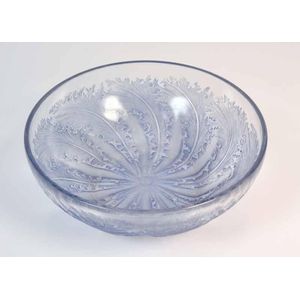R. Lalique 'Chicoree' Bowl - Art Deco Design
You must be a subscriber, and be logged in to view price and dealer details.
Subscribe Now to view actual auction price for this item
When you subscribe, you have the option of setting the currency in which to display prices to $Au, $US, $NZ or Stg.
- Patination / Patina - In broad terms, patination refers to the exterior surface appearance of the timber, the effect of fading caused by exposure to sunlight and air over the course of a century or more, changing the piece to a soft, mellow colour.
As patina is very difficult to replicate, it is one of the most important guides to determining the age of furniture.
Patina is also the term applied to the bloom or film found on old bronzes due to oxidisation. - Engraved Glass - The method of decorating glass by marking the surface with a sharp intrument such as a diamond, metal needle or rotating cutting wheel. As pressure is applied to the surface, best results for engraving are achieved if the glass is of sufficient thickness. In the 19th century etching was used to decorate some table glassware that was too fine to take an engraving tool.
- Art Deco Period - The Art Deco period was a cultural movement that emerged in the 1920s and 1930s, and was characterized by its emphasis on modernism, luxury, and elegance. The name "Art Deco" comes from the Exposition Internationale des Arts Décoratifs et Industriels Modernes, a large exhibition held in Paris in 1925 that showcased the latest trends in decorative arts.
Art Deco was a reaction against the ornate and elaborate styles of the previous era, and reflected a new modern sensibility. It was characterized by streamlined, geometric shapes, bright colours, and the use of new materials such as chrome, glass, and Bakelite. Art Deco designers sought to create a sense of luxury and sophistication, often incorporating expensive materials such as ivory, marble, and rare woods.
Art Deco had a significant impact on a wide range of artistic fields, including architecture, fashion, graphic design, and interior design. Some of the most iconic examples of Art Deco architecture include the Empire State Building in New York City, the Hoover Building in London, and the Palais de Chaillot in Paris.
The Art Deco period came to an end in the 1940s, as World War II and changing cultural trends led to a shift in artistic styles. However, Art Deco remains an important influence on design and art, and continues to be celebrated for its modernist sensibility and glamorous aesthetic.
This item has been included into following indexes:
Visually similar items

A large Annamese blue and white dish, 15th century, the shallow rounded sides rising to a flared and lipped rim, painted on the interior with a stylised lotus spray within a band of radiating leaves, and a floral scroll around the cavetto, below a band of

Two large Swatow blue and white dishes, late Ming, 17th century, Each one decorated with phoenix amongst exotic flowers, each base with kiln grit, 35 cm diameter and 47 cm diameter. Provenance: One purchased in Sydney, 1970's, The other one purchased from

Large Chinese blue and white bowl, 19th century, with stylised lotus design. Diameter 29 cm

Late 19th century Ethiopian silver coin dish, set with 1 gersh King Menelik II silver coin, 10.2 cm diameter, 68 grams
